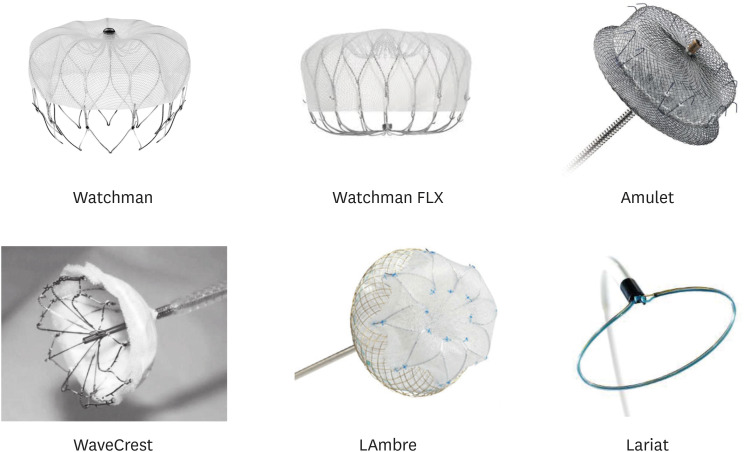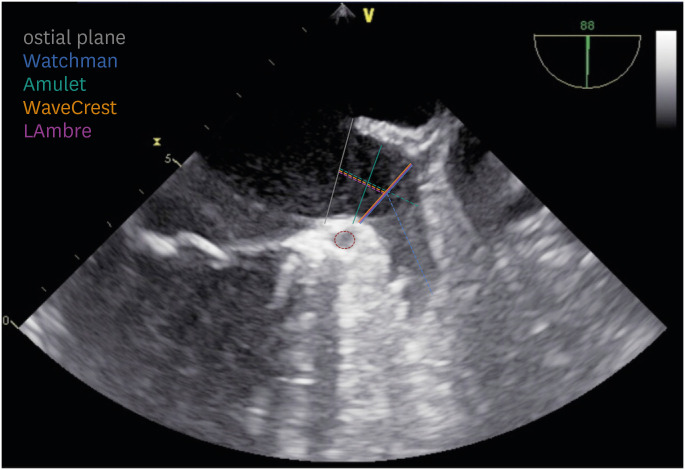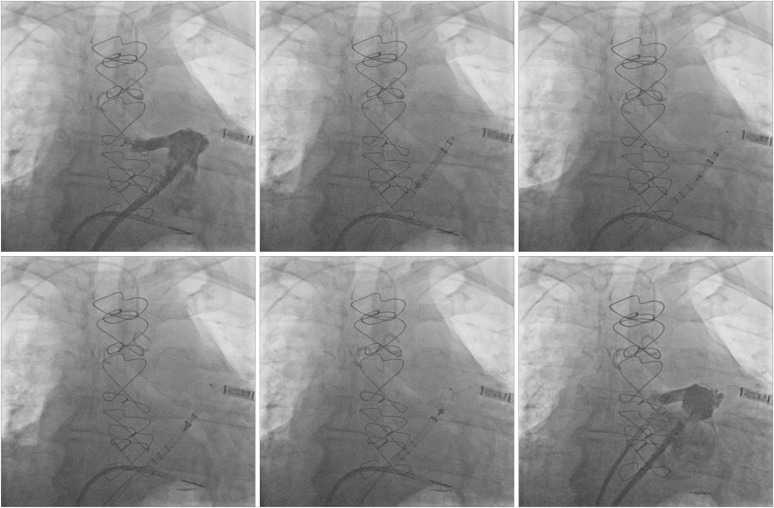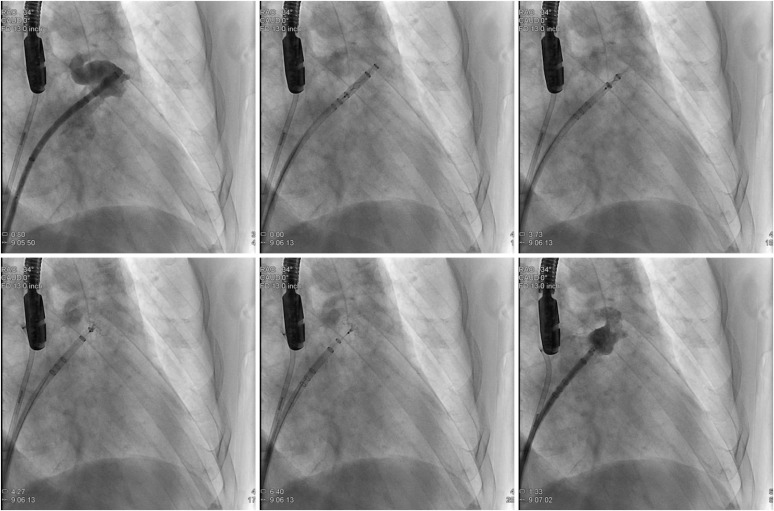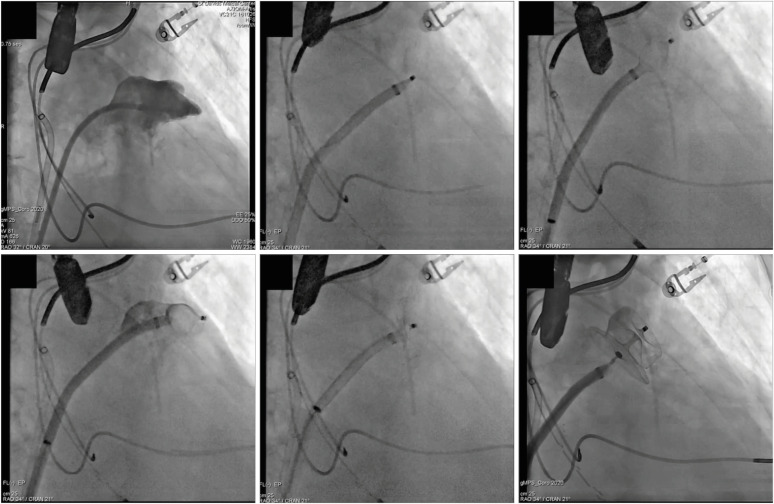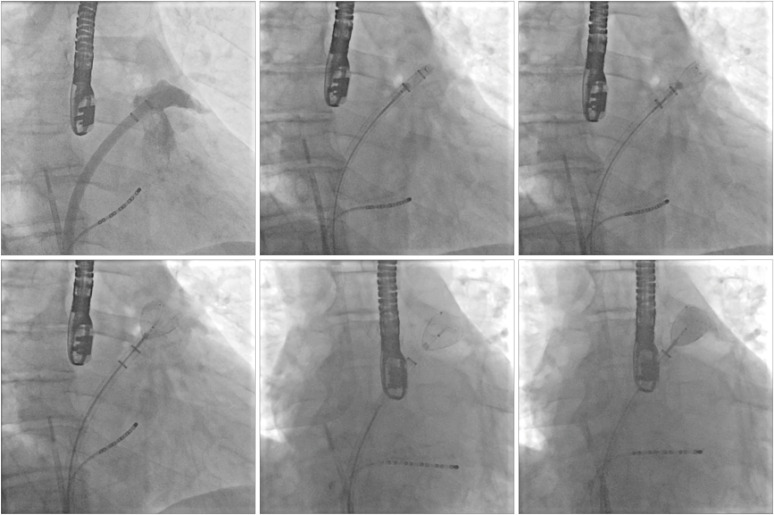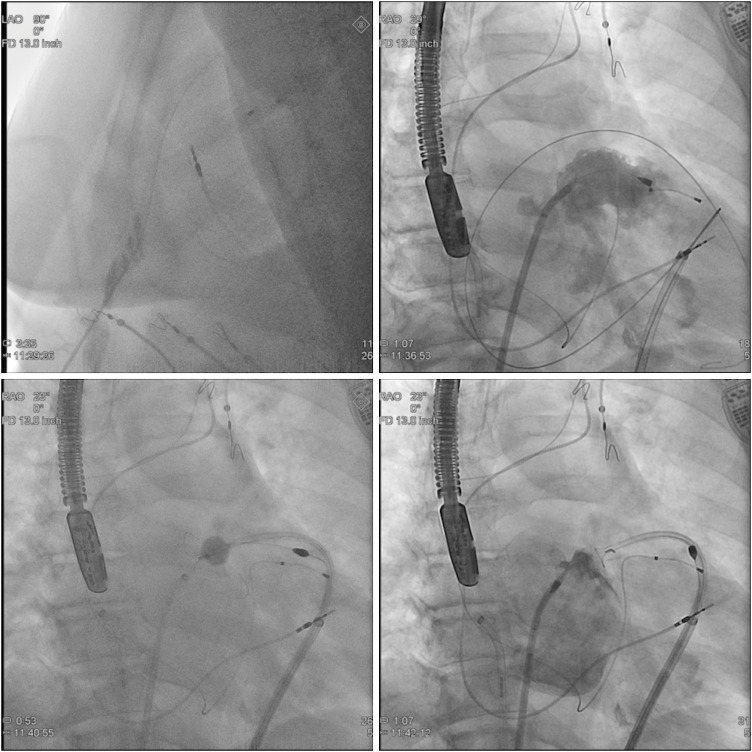Korean Circ J.
2021 Jan;51(1):1-14. 10.4070/kcj.2020.0416.
Interventional Treatment for Stroke Prevention
- Affiliations
-
- 1Texas Cardiac Arrhythmia Institute, St. David's Medical Center, Austin, TX, USA
- 2HCA National Medical Director of Cardiac Electrophysiology, USA
- 3Interventional Electrophysiology, Scripps Clinic, La Jolla, CA, USA
- 4MetroHealth Medical Center, Case Western Reserve University School of Medicine, Cleveland, OH, USA
- 5Department of Biomedical Engineering, University of Texas, Austin, TX, USA
- KMID: 2509900
- DOI: http://doi.org/10.4070/kcj.2020.0416
Abstract
- Closure of the left atrial appendage using percutaneous transcatheter occlusion devices is used for stroke prevention as an alternative for patients with a high risk or contraindications for long-term oral anticoagulation use. Herein, we will discuss the practical aspects of five among the available devices used for interventional left atrial appendage occlusion: Watchman, Amulet, WaveCrest, LAmbre, and Lariat.
Keyword
Figure
Reference
-
1. Wolf PA, Abbott RD, Kannel WB. Atrial fibrillation as an independent risk factor for stroke: the Framingham Study. Stroke. 1991; 22:983–988. PMID: 1866765.
Article2. Johnson WD, Ganjoo AK, Stone CD, Srivyas RC, Howard M. The left atrial appendage: our most lethal human attachment! Surgical implications. Eur J Cardiothorac Surg. 2000; 17:718–722. PMID: 10856866.
Article3. Madden JL. Resection of the left auricular appendix; a prophylaxis for recurrent arterial emboli. J Am Med Assoc. 1949; 140:769–772. PMID: 18152330.4. Beal JM, Longmire WP Jr, Leake WH. Resection of the auricular appendages. Ann Surg. 1950; 132:517–530. PMID: 15433218.
Article5. Nishimura RA, Otto CM, Bonow RO, et al. 2014 AHA/ACC guideline for the management of patients with valvular heart disease: executive summary: a report of the American College of Cardiology/American Heart Association Task Force on practice guidelines. J Am Coll Cardiol. 2014; 63:2438–2488. PMID: 24603192.6. January CT, Wann LS, Alpert JS, et al. 2014 AHA/ACC/HRS guideline for the management of patients with atrial fibrillation: a report of the American College of Cardiology/American Heart Association Task Force on practice guidelines and the Heart Rhythm Society. Circulation. 2014; 130:e199–267. PMID: 24682347.7. January CT, Wann LS, Calkins H, et al. 2019 AHA/ACC/HRS focused update of the 2014 AHA/ACC/HRS guideline for the management of patients with atrial fibrillation: a report of the American College of Cardiology/American Heart Association Task Force on clinical practice guidelines and the Heart Rhythm Society. J Am Coll Cardiol. 2019; 74:104–132. PMID: 30703431.8. Glikson M, Wolff R, Hindricks G, et al. EHRA/EAPCI expert consensus statement on catheter-based left atrial appendage occlusion – an update. Europace. 2019; euz258. PMID: 31504441.
Article9. Asmarats L, Rodés-Cabau J. Percutaneous left atrial appendage closure: current devices and clinical outcomes. Circ Cardiovasc Interv. 2017; 10:e005359. PMID: 29146668.10. Reddy VY, Doshi SK, Kar S, et al. 5-year outcomes after left atrial appendage closure: from the PREVAIL and PROTECT AF trials. J Am Coll Cardiol. 2017; 70:2964–2975. PMID: 29103847.11. Holmes DR, Reddy VY, Turi ZG, et al. Percutaneous closure of the left atrial appendage versus warfarin therapy for prevention of stroke in patients with atrial fibrillation: a randomised non-inferiority trial. Lancet. 2009; 374:534–542. PMID: 19683639.
Article12. Viles-Gonzalez JF, Kar S, Douglas P, et al. The clinical impact of incomplete left atrial appendage closure with the Watchman Device in patients with atrial fibrillation: a PROTECT AF (Percutaneous Closure of the Left Atrial Appendage Versus Warfarin Therapy for Prevention of Stroke in Patients With Atrial Fibrillation) substudy. J Am Coll Cardiol. 2012; 59:923–929. PMID: 22381428.13. Holmes DR Jr, Kar S, Price MJ, et al. Prospective randomized evaluation of the Watchman Left Atrial Appendage Closure device in patients with atrial fibrillation versus long-term warfarin therapy: the PREVAIL trial. J Am Coll Cardiol. 2014; 64:1–12. PMID: 24998121.14. Doshi SK, Sadhu A, Horton RP, et al. Primary outcome evaluation of a next generation left atrial appendage closure device: the PINNACLE FLX trial. Heart Rhythm. 2020; 17:S74.15. Landmesser U, Tondo C, Camm J, et al. Left atrial appendage occlusion with the AMPLATZER Amulet device: one-year follow-up from the prospective global Amulet observational registry. EuroIntervention. 2018; 14:e590–7. PMID: 29806820.
Article16. Stone GW. WaveCrest: device description, data, and future directions [Internet]. New York: TCTMD;2017. cited 2020 October 5. Available from: https://www.tctmd.com/slide/wavecrest-device-description-data-and-future-directions.17. Huang H, Liu Y, Xu Y, et al. Percutaneous left atrial appendage closure with the LAmbre device for stroke prevention in atrial fibrillation: a prospective, multicenter clinical study. JACC Cardiovasc Interv. 2017; 10:2188–2194. PMID: 29122133.18. Price MJ, Gibson DN, Yakubov SJ, et al. Early safety and efficacy of percutaneous left atrial appendage suture ligation: results from the U.S. transcatheter LAA ligation consortium. J Am Coll Cardiol. 2014; 64:565–572. PMID: 25104525.19. Gianni C, Anannab A, Sahore Salwan A, Della Rocca DG, Natale A, Horton RP. Closure of the left atrial appendage using percutaneous transcatheter occlusion devices. J Cardiovasc Electrophysiol. 2020; 31:2179–2186. PMID: 32249473.
Article20. Hur J, Kim YJ, Lee HJ, et al. Left atrial appendage thrombi in stroke patients: detection with two-phase cardiac CT angiography versus transesophageal echocardiography. Radiology. 2009; 251:683–690. PMID: 19366905.
Article21. Enomoto Y, Gadiyaram VK, Gianni C, et al. Use of non-warfarin oral anticoagulants instead of warfarin during left atrial appendage closure with the Watchman device. Heart Rhythm. 2017; 14:19–24. PMID: 27771552.
Article22. Korsholm K, Jensen JM, Nielsen-Kudsk JE. Intracardiac echocardiography from the left atrium for procedural guidance of transcatheter left atrial appendage occlusion. JACC Cardiovasc Interv. 2017; 10:2198–2206. PMID: 28866042.23. Della Rocca DG, Horton RP, Di Biase L, et al. First experience of transcatheter leak occlusion with detachable coils following left atrial appendage closure. JACC Cardiovasc Interv. 2020; 13:306–319. PMID: 31954677.24. Imazio M, Brucato A, Ferrazzi P, et al. Colchicine for prevention of postpericardiotomy syndrome and postoperative atrial fibrillation: the COPPS-2 randomized clinical trial. JAMA. 2014; 312:1016–1023. PMID: 25172965.25. Gunda S, Reddy M, Nath J, et al. Impact of periprocedural colchicine on postprocedural management in patients undergoing a left atrial appendage ligation using LARIAT. J Cardiovasc Electrophysiol. 2016; 27:60–64. PMID: 26515657.
Article26. Chahar P, Cummings KC. Liposomal bupivacaine: a review of a new bupivacaine formulation. J Pain Res. 2012; 5:257–264. PMID: 23049275.
- Full Text Links
- Actions
-
Cited
- CITED
-
- Close
- Share
- Similar articles
-
- Antiplatelet Therapy for Secondary Stroke Prevention in Patients with Ischemic Stroke or Transient Ischemic Attack
- The connection between diabetes mellitus and stroke: a brief review
- Secondary Prevention as Integral Part of Stroke Rehabilitation
- Interventional Recanalization Treatment of Acute Ischemic Stroke
- Corrected and Republished: Interventional Treatment for Stroke Prevention

